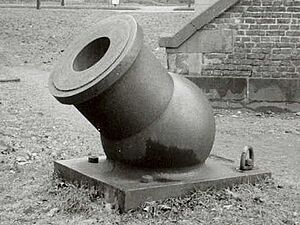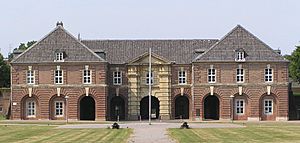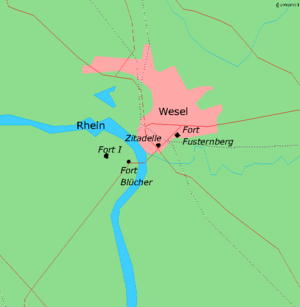Wesel Citadel facts for kids
The Wesel Citadel is a huge old fortress in the city of Wesel, Germany. It's the biggest and best-preserved old fort in the Rhineland area. Built between 1688 and 1722, it was designed like a five-pointed star. Each point of the star was a strong part called a bastion, which helped defend the fort. The citadel was the most important part of the entire Wesel fortress. Today, it's a lively place used for cultural events and museums.
Building the Wesel Citadel
The Wesel Citadel was built using ideas from Sébastien Le Prestre de Vauban, a famous French engineer who designed many strong forts. His methods made forts very hard to attack. Building the citadel was very expensive. For example, between 1668 and 1700, it cost about 373,452 Reichsthaler, which was a huge amount of money back then! The whole Wesel fortress, including the citadel, had about 250 cannons ready for defense.
In 1687, Frederick William I of Brandenburg ordered the citadel to be built. He wanted Wesel to be a very strong, fortified city. The citadel was planned for the south side of the city and would connect to the existing city walls. It was designed with five bastions and five ravelins, which are outer defenses shaped like triangles. The main gate of the citadel, which is still impressive today, was finished in 1718.
Later, before the mid-1700s, the citadel was made even stronger, especially on its south and east sides. When French soldiers occupied the citadel from 1805 to 1814, they added a two-story brick building. This building, known as Barracks VIII, is still standing today. The main gate of the citadel is very grand. It even has a prison cell in its southern part. This cell once held eleven officers who fought with Ferdinand von Schill.
What the Citadel is Used For Today
After World War I, around 1919 and 1920, many parts of the old Wesel fortifications were taken down. Especially the parts facing the Rhine and Lippe rivers, where enemies might have come from, are now gone. Only a street name reminds people where an old gate used to be.
Even though much of the old fortress was removed, several important buildings within the citadel remained. These buildings are now used for different purposes:
- Main Gate: This gate, built in 1718, still stands with its bridge and trenches. It was repaired in 1823. Today, it houses the "Städtische Museum Abteilung Schillkasematte," which is a local museum. This gate was also a strong defense point and connected the citadel to the city.
- Officers' Prison: Built in 1727, this building is now owned by private individuals.
- Garrison Bakery No. II: This old bakery from 1809 now holds the local city archive and a department that restores old documents.
- Barracks No. VIII: Built in 1809 by the French, this building has been renovated. It is now home to the city's "Musik- und Kunstschule" (Music and Art School).
- Körner Magazine: This building from 1835 now contains the Prussian Museum of North Rhine Westphalia.

Important Leaders of the Citadel
The Wesel Citadel had many important leaders, called governors, over the centuries. These were usually high-ranking military officers who were in charge of the fortress. Here are a few examples:
- Alexander von Spaen: He was a very high-ranking general and became governor in 1675.
- Carl Philipp Reichsgraf von Wylich und Lottum: Another important general who served as governor starting in 1702.
- Friedrich Wilhelm von Dossow: He was a General of the Infantry and governor around 1750.
- Heinrich August de la Motte Fouqué: A General-Leutnant who became governor in 1757.
- William I, Elector of Hesse: A very important leader who was a Generalfeldmarschall and became governor in 1797.




